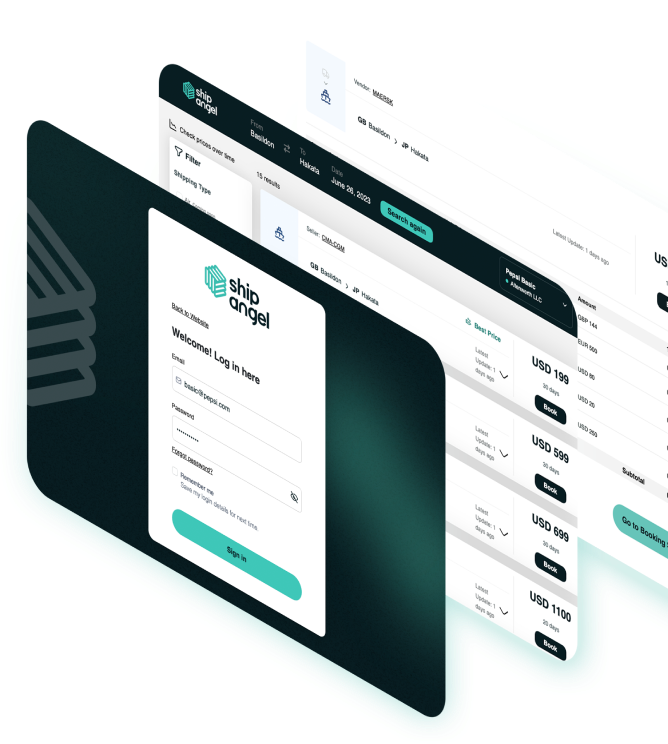.png)
I. The Cracks Are Showing
The global freight stack was never designed for the world we live in today. What was once a patchwork of legacy systems, siloed tools, and manual processes has become a liability for shippers navigating volatile markets, rising costs, and growing pressure for speed and accuracy.
The problem? Everyone tried to fix a broken system by layering more tech on top — but no one rebuilt the foundation.
And nowhere is the failure more visible than in freight booking. For all the talk of digitization, most bookings still involve emails, PDFs, and painfully delayed confirmations. While other industries move at API speed, the average ocean booking still limps along at 2005 pace.
This blog isn’t just a teardown — it’s a clear look at what’s wrong, and a vision for what comes next.
II. Where the Freight Stack Falls Apart
The problems are well known to anyone working in freight:
- Fragmented Systems
Freight teams jump between TMS platforms, Excel sheets, rate tools, and email threads. Nothing talks to each other. Information gets lost or duplicated. - Manual Overload
Booking, auditing, managing rate amendments — it’s all too manual. Every new shipment becomes a scavenger hunt for data and approvals. - Rigid Legacy Tools
Most TMS or freight platforms are built for stability, not adaptability. When the market shifts, systems lag behind. - Booking Bottlenecks
Let’s be clear: booking is the biggest failure point in the entire freight stack.
- Carriers promise APIs, but they’re fragmented and unreliable
- Integrations take months — or never fully work
- Teams still rely on emails to confirm sailings and secure space
- Booking visibility is slow, disconnected, and full of risk
- Integrations take months — or never fully work
For shippers managing thousands of containers, this broken link isn’t just frustrating — it’s expensive, time-consuming, and dangerous for supply chain performance.
III. Why Incremental Fixes Aren’t Enough
Freight platforms have tried to fix things by layering on new modules or API wrappers. But these fixes are surface-level.
- Adding a booking widget to an outdated system doesn’t solve the root issue
- “Integrated” tools still rely on manual work behind the scenes
- Carrier APIs are not normalized — each one behaves differently, requiring custom builds
It’s like adding a spoiler to a car with a failing engine. The core architecture of the freight stack was never built for automation — especially not for reliable, multi-carrier booking.
The answer isn’t more patches. It’s starting over.
IV. What Comes Next: The New Freight Stack
To move forward, we need to rethink the freight stack from the ground up — starting with booking.
1. AI-Native Core
Smart systems that can ingest contracts, identify discrepancies, flag errors, and optimize decisions in real time.
2. Booking-First Infrastructure
Booking shouldn’t be a final step — it should be the heartbeat of the platform.
- Instant space requests
- Live confirmations
- Built-in carrier communication
- A true booking control tower — not a form that generates an email
3. Unified Rate Intelligence
A central source of truth for rates, surcharges, and benchmarks — not scattered Excel files and static PDFs.
4. Real-Time Collaboration
Built-in messaging with vendors, carriers, and internal teams. No more jumping to Outlook or Slack.
5. Dynamic Flexibility
Booking changes, rate amendments, or cancellations shouldn’t take 48 hours. They should be instant, with the system adapting in real time.
This is what a freight stack should look like in 2025 — not stitched together with spreadsheets and wishful integrations.
V. The Business Case for Making the Switch
The broken booking layer is more than just a workflow issue — it’s a business risk.
|
Old Stack |
New Stack |
|
Email-based booking |
API-native, live bookings |
|
Weeks to onboard carriers |
Instant carrier connections |
|
Manual audits |
Automated invoice validation |
|
Siloed rate files |
Centralized rate intelligence |
|
Inflexible workflows |
Dynamic, customizable processes |
Making the switch delivers measurable results:
- Fewer errors and chargebacks
- Faster planning and execution
- More accurate landed cost forecasts
- A scalable, modern freight team
VI. What Forward-Thinking Shippers Are Already Doing
Some of the world’s most advanced shippers are already rethinking their booking layer. Not by plugging in new point tools — but by adopting freight operating systems designed around:
- Carrier API orchestration
- Rate clarity and contract digitization
- Live booking visibility
- Built-in collaboration with vendors
In one case, a food and beverage shipper cut average booking time from 2 days to under 2 hours — not by hiring more people, but by replacing the broken stack with a smarter one.
VII. Closing: Rebuild What Moves the World
The global supply chain depends on freight — but the tools supporting it haven’t kept up. The freight stack is broken. The booking layer is the biggest bottleneck. And shippers can’t afford to wait.
What comes next isn’t just another layer of tech. It’s a complete reset:
AI-native, booking-first, and built for the complexity of today’s global supply chains.
Ship Angel is at the center of this shift. We’ve rebuilt the freight stack from scratch — with real-time bookings, clean rate data, and AI that works behind the scenes.
Want to see what comes next?
Explore the platform → www.shipangel.com
 Graham Parker
Graham Parker
 July 8, 2025
July 8, 2025
